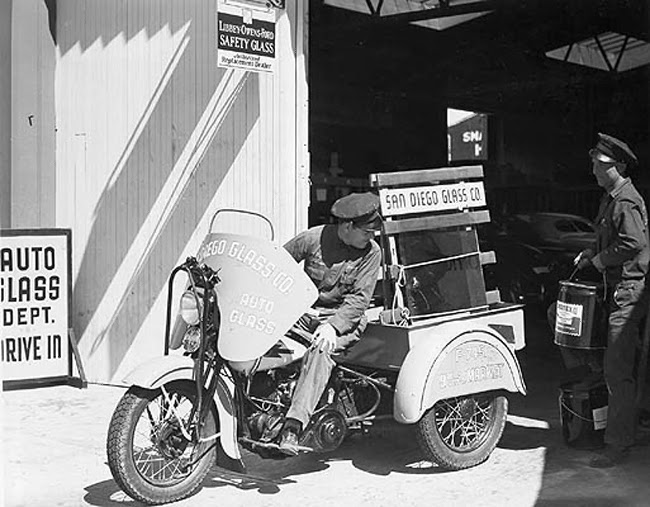The three-wheeled Servi-Car was Harley-Davidson's third motorcycle purposely designed for commercial use. Before it's introduction in 1932, Harley had tried to enter the commercial market, first with the motorcycle truck and then with the package truck. Neither of these vehicles had the success that Harley was to have with the Servi-Car. It would become Harley's longest continuous production motorcycle, being manufactured up until 1973. People usually associate the Servi-Car with the 45" flathead which had powered the WLA during World War II, but this was not the only engine used to power the Servi-Car.
When the Servi-Car first rolled off the line in 1932, it was powered by the new R-series side-valve engine. The R-series was designed as a replacement for the unsuccessful D-series (also a 45" side-valve V-twin) which had been built from 1929 until 1931. Visually the two engines can be easily distinguished by their generators, with the D-series having a vertically mounted unit and the R-series with the more familiar horizontal mounting. The real differences are inside the motor as the R-series had a number of improvements made to the flywheels, crankcases, barrels, pistons, conrods and oil pump.
Like many Harley's, the Servi-Car borrowed heavily from other models, sharing many of the same parts with the two-wheeled motorcycles of it's day. It used a tubular single down tube frame with a rear subframe to accommodate the rear axle and sheet metal rear box. The rear box was available in two sizes and could be specified to include an air tank. A hand-shifted three-speed transmission with reverse mated to the R-series motor made maneuvering the 630 lbs Servi-Car a breeze.
The Servi-Car was designed to be operated by someone without any previous experience on a motorcycle, hence it's three wheel configuration. This also made it towable without the need for a trailer. Harley capitalized on this design advantage by including a front tow bar which could be attached to the rear bumper of an automobile without the need of a hitch. This option made Servi-Cars highly popular with service stations who used them as delivery vehicles. Back in the 1930s when you had your automobile serviced, the service station would deliver it to your home or work when it was completed. Having a Servi-Car in-tow allowed these deliveries to be made with just one driver who would simply unhook the Servi-Car and ride it back to the station once the customer's automobile had been delivered.
(via Riding Vintage)
When the Servi-Car first rolled off the line in 1932, it was powered by the new R-series side-valve engine. The R-series was designed as a replacement for the unsuccessful D-series (also a 45" side-valve V-twin) which had been built from 1929 until 1931. Visually the two engines can be easily distinguished by their generators, with the D-series having a vertically mounted unit and the R-series with the more familiar horizontal mounting. The real differences are inside the motor as the R-series had a number of improvements made to the flywheels, crankcases, barrels, pistons, conrods and oil pump.
Like many Harley's, the Servi-Car borrowed heavily from other models, sharing many of the same parts with the two-wheeled motorcycles of it's day. It used a tubular single down tube frame with a rear subframe to accommodate the rear axle and sheet metal rear box. The rear box was available in two sizes and could be specified to include an air tank. A hand-shifted three-speed transmission with reverse mated to the R-series motor made maneuvering the 630 lbs Servi-Car a breeze.
The Servi-Car was designed to be operated by someone without any previous experience on a motorcycle, hence it's three wheel configuration. This also made it towable without the need for a trailer. Harley capitalized on this design advantage by including a front tow bar which could be attached to the rear bumper of an automobile without the need of a hitch. This option made Servi-Cars highly popular with service stations who used them as delivery vehicles. Back in the 1930s when you had your automobile serviced, the service station would deliver it to your home or work when it was completed. Having a Servi-Car in-tow allowed these deliveries to be made with just one driver who would simply unhook the Servi-Car and ride it back to the station once the customer's automobile had been delivered.
(via Riding Vintage)























